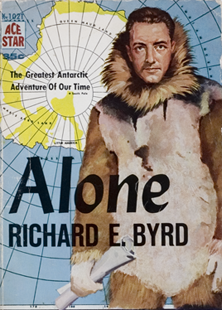Admiral Richard Evelyn Byrd (1888 – 1957)
 Rear Admiral Richard E. Byrd, Jr., USN was a pioneering American aviator, polar explorer, and organizer of polar logistics. He undertook five expeditions to Antarctica and made the first-ever flight over the South Pole on November 28, 1929. Byrd was a recipient of the Medal of Honor, the highest honor for heroism given by the United States.
Rear Admiral Richard E. Byrd, Jr., USN was a pioneering American aviator, polar explorer, and organizer of polar logistics. He undertook five expeditions to Antarctica and made the first-ever flight over the South Pole on November 28, 1929. Byrd was a recipient of the Medal of Honor, the highest honor for heroism given by the United States.
Byrd experimented in navigation without visual landmarks during World War I, resulting in his appointment by the United States Navy to plan the flight navigation for the first-ever transatlantic flight in 1919. In 1926 he and Floyd Bennett made the first flight over the North Pole, though scholars have since raised questions about the success of the expedition. From there he turned his sights southward.
First Antarctic Expedition 1928-30
The 1928-30 Byrd Expedition was the first American expedition to explore Antarctica since the U.S. Exploring Expedition under Charles Wilkes in 1840. The expedition launched a revival of American interest in the Antarctic and may be considered the first of the mechanical age of exploration in Antarctica. The program was the first to utilize the airplane, aerial camera, snowmobile and massive communications resources.
Byrd constructed a base camp named “Little America” on the Ross Ice Shelf (about four miles north of Amundsen’s base camp, Framheim) and the team underook photographic expeditions and geological surveys by dog-sled, snowmobile and airplane throughout the summers of 1928, 1929, all the while maintaining constant radio communications with the outside world. On November 28, 1929, Byrd, along with pilot Bernt Balchen, co-pilot/radioman Harold June, and photographer Ashley McKinley, made their historic first-flight over the South Pole, in 18 hours, 41 minutes. Several other exploratory flights were later made. One was to the east, along the edge of the Ross Ice Shelf and coast to 150W, further than anyone had previously explored. Another flew 100 miles (161 km) west to Discovery Inlet, south for 140 miles (225km) across the middle of the Ross Ice Shelf, and back to Little America.
Other significant expedition achievements included surveys of the Rockefeller Mountains and extensive geological studies. The geological party covered 1500 miles over two-and-a-half months, mapping 175 miles (282 km) along the front of the Queen Maud Mountains to the foot of the Leverett Glacier at 85°25’17″S, 147°55’W. They deposited a record of their visit on top of a nearby mountain, which they named Supporting Party Mountain, and claimed all the land east of 150°W as part of Marie Byrd Land (after Byrd’s wife) and territory of the United States.
Daily newspaper and radio accounts, particularly of the South Polar flight and discovery of Marie Byrd Land, made Byrd a household name throughout America. He was promoted to the rank of Rear Admiral, making him (at age 41) the youngest admiral in the history of the United States Navy.
Second Byrd Antarctic Expedition 1933–35
Byrd quickly launched a second expedition to Antarctica, building on the momentum of his achievements.
The expedition had four primary exploration objectives: the delineation of as much as possible of the coastline of Marie Byrd Land; additional research in the Ford Ranges; determination of an ice-filled strait connecting the Ross Sea with the Weddell Sea; determination of the extent of the Queen Maud Mountains beyond the Ross Ice Shelf.
The scientific program included proposals to measure the thickness of the Ross Ice Shelf and polar plateau, extensive biological investigation ranging from plankton to the seals in the Bay of Whales and surveying of the front of the Ross Ice Shelf to determine what changes since the last survey made by Scott’s Terra Nova Expedition in 1911. Meteorological observation was also an important part of the expedition. An Advance Base was constructed at 80°08’S, 163°57’W, 123 miles (198 km) from Little America II and Byrd spent most of the winter of 1934 there alone. His winter weather observations were the first taken from the interior. This effort almost cost Byrd his life when he was poisoned by carbon monoxide fumes.
A number of “firsts” were accomplished during the Second Byrd Antarctic Expedition. Results from the first seismic investigations in Antarctica provided the initial evidence of the extent to which the Ross Ice Shelf was aground or afloat. The first human voices were transmitted from Little America on February 1, 1934 and later a weekly broadcast was carried over the Columbia Broadcasting System in the United States. Additionally, this expedition marked the first time that cosmic ray and meteor observations were taken in such high southern latitudes. Although the First Byrd Antarctic Expedition was the beginning of the mechanical age in Antarctica, the Second Expedition took mechanical and electrical resources to a new level. Motor-driven generating plants provided Little America with electrical power, thereby allowing use of electrical power tools used in construction and maintenance of mechanical devices used at Little America as well as exercises in the field.
Antarctic Service Expedition (1939-1940)
Byrd’s third expedition was his first one on which he had the official backing of the U.S. government. The principal objective was the delineation of the continental coast line between the meridians 72 degrees W., and 148 degrees W., and the consolidation of the geographical features of Hearst Land, James W. Ellsworth Land, and Marie Byrd Land. A second objective involved the delineation of the then-unknown west coast of the Weddell Sea between Cape Eielson and Luitpold Coast. Of significance was the establishment and occupation for a year of two separate bases 1600 miles (2575 km) apart by air and 2200 miles (3541 km) by sea. Observations were concluded in every conceivable area: seismic, cosmic ray, auroral, biological, tidal, magnetic and physiological to name a few. All in all, it was an extremely successful expedition.
Flights by seaplane from the USS BEAR and by land based airplanes from Little America III resulted in approximately 700 miles (1127 km) of coastline being added to the map of Antarctica. Reconnaissance flights revealed previously unknown parts of the Ross Ice Shelf. Gaps in the unexplored regions between the Beardmore and Liv Glaciers in the Queen Maud Mountains were also filled in. Further aerial reconnaissance from East Base extended the coastline of Antarctica westward to about the 85th meridian, west.
A sledging party discovered the western outlet of George VI Sound, settling once and for all that Alexander Island was indeed an island. Other sledge teams conducted a ground survey of the east coast of the Antarctic Peninsula; triangulated the position of 58 mountains; collected biological and geological specimens; and photographed the terrain they covered. The first high-altitude meteorological station in Antarctica was operated during November and December, 1940.
Operation Highjump (1946-1947)
In 1946, Byrd was put in charge of the Antarctic Developments Project, planned for December 1946 – March 1947. The expedition, code named Operation Highjump, was and to this day still is, the largest Antarctic expedition ever organized.
Unlike Byrd’s previous expeditions, Operation Highjump’s goals were primarily of a military nature. Instructions were for twelve ships and several thousand men to make their way to the Antarctic rim to:
- train personnel and test material in the frigid zones
- consolidate and extend American sovereignty over the largest practical area of the Antarctic continent
- determine the feasibility of establishing and maintaining bases in the Antarctic and to investigate possible base sites
- develop techniques for establishing and maintaining air bases on the ice and the applicability of such techniques to operations in Greenland
- amplify existing knowledge of hydrographic, geographic, geological, meteorological and electromagnetic conditions in the area
The armada arrived in the Ross Sea on December 31, 1946, and made aerial explorations of an area half the size of the United States, recording ten new mountain ranges. The major area covered was the eastern coastline of Antarctica from 150 degrees east to the Greenwich meridian.
Operation Deep Freeze I (1955-1956)
As part of the multinational collaboration for the International Geophysical Year (IGY) 1957–58, Byrd commanded the U.S. Navy Operation Deep Freeze I in 1955–56, which established permanent Antarctic bases at McMurdo Sound, the Bay of Whales, and the South Pole. This was Byrd’s last trip to Antarctica and would mark the beginning of a permanent U.S. military presence in Antarctica.





